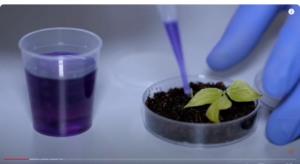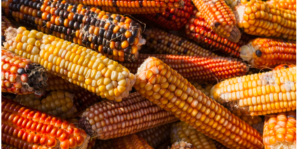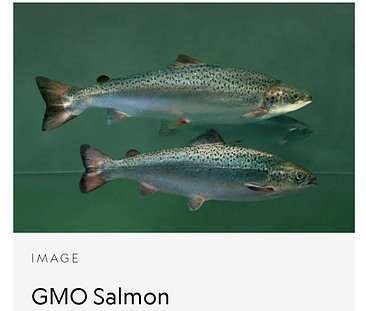Benefits and Risks of GMOs – Better Health or Medical Problems
Despite all the efforts to live a healthy lifestyle and the promises you make to go green; you still don’t have control of what goes in and what is taken out of your foods. 
However, the FDA, EPA and the USDA, are doing everything in their power to ensure that GMOs are safe for human, plant, and animal health. In addition, these agencies also monitor the benefits and risks of GMOs on the environment.
Benefits and Risks of GMOs and FDA Regulations
The FDA regulates human and animal food from plants produced through use of genetic engineering. It takes into consideration the benefits and risks of GMOs. Under the Federal, Food, Drug, and Cosmetic Act (FD&C Act) they are held to the same standards as all foods produced, processed, stored, shipped or sold in the United States.
GMO Labeling
Genetically engineered plants are approved for sale and don’t need labels. Anyone on a plant-based diet, have no worries, these plants are safe to eat.
According to a policy established in 1992, FDA considers all the benefits and risks of GMOS. In fact, they consider most GM crops as “substantially equivalent” to non-GM crops. In such cases. GM crops are designated as ‘Generally Recognized as Safe” under the Federal Food, Drug, and Cosmetic Act (FFDCA) and do not require pre-market approval.
EPA Regulatory Role
EPA regulates pesticides, including genetically engineered pesticides, under the following two laws: Federal Insecticide, Fungicide and Rodenticide Act (FIFRA) This act provides the legal requirements for EPA’s registration process for all pesticides.
What is Meant by GMO?
A genetically modified organism contains DNA that is altered using genetic engineering. Genetically modified animals are mainly used for research purposes, while genetically modified plants are common in today’s food supply. A GMO is an animal, plant, microbe who has manipulated DNA. Find out more abour your own DNA. It’s pretty fascinating. 
Three Biosafety Principles of GMO
- Principles of Precaution
- The Polluter Pays
- Principle of Public Participation
GMOs for Clothing, Medicine and Fuel
Did You Know that Genetic engineering is often used in combination with traditional breeding to produce the genetically engineered plant varieties on the market today? However, the principles of precaution, polluter pays, and public participation must be in place for sustainable development. These principles consider the environmental, economic and societal effects of GMOs. In retrospect, the use of GMOs is more appreciated and less critiqued than in the past. In fact, there are GMO clothing, medicine and fuel.
History of GMOs
The first genetically engineered plants, produced for human consumption appeared in the mid-1990s. Today, approximately 90 % of corn, soybeans, and sugar beets on the market are GMOs. Genetically engineered crops produce higher yields, have longer shelf life and are resistant to diseases and pests. Ironically, they taste better.
Early strawberry farmers developed crossbreeding methods to grow corn with a range of colors, sizes, and uses. On the other hand, if you want to learn more about organic farmimg, this is your lucky day.
Strawberries are Cross Bred
Today’s strawberries are a cross bred. North American strawberries are bred with South American strawberries. In fact, most of the foods we eat today came about through traditional breeding methods. However, changing plants and animals through traditional methods takes a lot more time.
Benefits of GMOs
These benefits are a plus for farmers and consumers. For example, higher yields and longer shelf life leads to lower prices for consumers. Also, pest-resistant crops means that farmers don’t need to buy and use as many pesticides to grow quality crops. In effect, GMO crops are kinder to the environment than conventionally grown crops.
The Downside of GMOs
Genetically modified foods do cause controversy. Genetic engineering changes an organism in a way that would not occur naturally. It is common for scientists to insert genes from one organism into an entirely different organism. This raises the risk of unexpected allergic reactions to some GMO foods. This also spreads Foreign DNA to other plants and animals. So far, all of the approved GMOs abide by regulations and rigorous safety standards. 
Foreword Outlook
In the future, GMOs will continue to play an important role in biomedical research. GMO foods provide better nutrition and are better engineered to enhance human health. If they continue to be safe and healthful, consumer resistance to these products will most likely diminish.
Genetically Modified Organisms
For thousands of years, humans used breeding methods to modify organisms. Crops, cattle, and even dogs were selectively bred over generations to have certain desired traits. Within the last few decades, however, modern advances in biotechnology allow scientists to directly modify the DNA of microorganisms, crops, and animals
What Foods Contain GMOs?
Most of the animals in laboratories are research subjects. These studies track specific genes and show how they relate to health and disease. However, some GMO animals are produced for human consumption. Salmon, for example, has been genetically engineered to mature faster. Despite their rapid maturation, the U.S. Food Administration has deemed that these fish are safe to eat.
Check out the produce section of your local grocery store. They are replete with GMO products. 
Most Common GMOs
The most common GMOs are corn, soy, cotton, papaya, potato, sugar beet. Notice the top three. According to the U.S. Department of Agriculture, corn, soy, and cotton are among the top three crops in the U.S. Here are a few general statistics:
Soy: Up to 90% of soybeans in the market have been genetically modified to be naturally resistant to the herbicide Roundup.
Corn: Half of the U.S. farms growing corn to sell to the conglomerate, Monsanto, are growing GMO
Alfalfa: Much of commercially available alfalfa has been genetically modified to contain a gene that makes it resistant to the herbicide Roundup.
Canola. It is estimated that 90% of U.S. canola crops are genetically modified.
Bananas: The bananas available in the U.S. grocery stores is a cultivar called the Cavendish banana. This type of banana is a non-GMO banana that is not currently available as a GM variety, or GMO in the U.S. So, the banana that you buy in the grocery store are GMO-free. In addition, bananas are being improves in Uganda.
Biotechnology in Africa
Biotechnology is currently being used to improve bananas in Africa. For example, a research program in Uganda is working on a GM banana that could help prevent vitamin A deficiency. Although the bananas in your local market are not yet genetically, modified, they could become GMO in the future. For the record, there are over 50 varieties of bananas in Africa. 
No GMOs in Seedless Crops
Seedless fruits. Seedless fruits and plants are not GMO. They are not common, but they do exist naturally or can be manipulated by fruit and plant breeders without using genetic engineering techniques. No current seedless plants or fruit are genetically modified organisms. For instance, there are no GMO tomatoes on the market anywhere in the world today.
The Flavr Savr Grape Flatlined
However, there was one back in the 90s (the Flavr Savr), but it didn’t sell well, so it was taken off the market. Seedless watermelon and grapes are not GMOs. They are not genetically modified foods. Watermelon is a result of crossbreeding. The male pollen, containing 22 chromosomes is crossed with the female watermelon flower, which has been chemically altered to contain 44 chromosomes.
Can You Reproduce a Seedless Fruit?
You can’t plant a seedless fruit, because the plants that produce them don’t occur in nature because they are sterile. That means they can’t reproduce. On the other hand, apples are the first GMO in the history of the world. Consumers will buy them in spite of the fact that they are GMO.
Can Seedless Grapes be Organic?
Organic or not, all seedless grapes are “unnatural.” Although a rare mutant plant could be natural, the seedless form is not naturally grown. Therefore, they are not organic. However, the process of growing seedless grapes uses a form of asexual reproduction. Although seedless fruits are labeled unnatural, they are very delicious. Too bad they are not considered an organic fruit. So, we all have our own choices when it comes to our food choices.
Final Take Home
In terms of the current food situation, we have the freedom of choice. We can select organic, regular or genetically modified foods. Since all of our foods have to go through the regulation channels of the Food and Drug Administration, this should suffice for many people. This organization is responsible for ensuring the safety, efficacy, and security of human and veterinary drugs, biological products, medical devices, tobacco products, cosmetics, and electronic products that emit radiation.
Yours truly.
Rachele, Founder
web: mybluegenes.com
email: rachele@mybluegenes.com
As an Aazon affiliate I earn from qualifying purchases at NO extra cost to you.







Wow! I never knew that Salmon ? was GMO to mature faster. Amazing & insightful blog!!!
Thank you for sharing this!!
Hi, Gina
Thanks for your response.
It is a lot that we can learn about our food supply. I will be posting more information about this in subsequent articles. My website is fairly new, but I plan to have the full scope on all things related to our health and wellness. I am also increasing my own knowledge as I am doing daily research.
I really appreciate your interest in the topic of GMOs.
Rachele